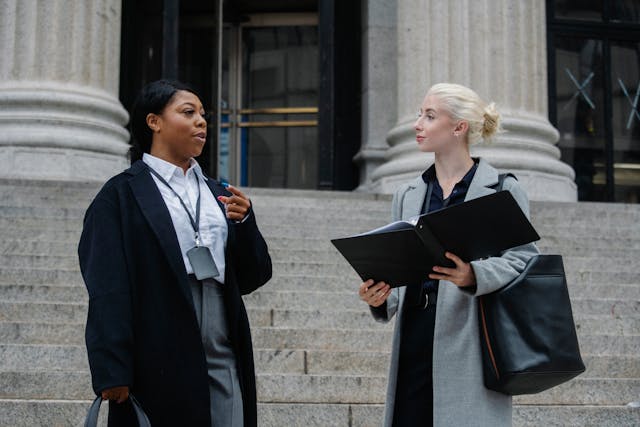Supreme Court overturns decision in Bauer v. Marks case, forcing fresh review of police‐use limits under Fourth Amendment.
When the Supreme Court vacates a decision, things change fast, and sometimes in ways no one fully expected. That’s exactly what’s happening now, after the Court overturned the prior ruling in Bauer v. Marks, sending it back for reconsideration. For civil rights watchers, police reform advocates, constitutional scholars, and everyday citizens alike, this case matters. It probes the frontier of qualified immunity, use of force by law enforcement, and the shifting balance between security and individual rights. Understanding Supreme Court decisions requires examining how they shape legal precedents and regulations that affect everyone. If you’re involved in a case with similar constitutional questions, connecting with qualified legal counsel who understands these complex rulings is essential.
In this article, I’ll walk you through how we got here, what the high court did (and didn’t) do, the stakes for future policing, and why the decision feels like stepping into a shifting legal landscape. I’ll also surface tensions and contradictions, because law is rarely clean, and leave you with the most important takeaways to carry forward.
Article Breakdown
Background: Marks v. Bauer: What the Lower Courts Decided
Before we dive into the Supreme Court’s action, we need clarity on what Bauer v. Marks was all about.
The Incident
In the aftermath of George Floyd’s death and the unrest that followed, Minneapolis was tense. Officer Benjamin M. Bauer, working with a team, responded to a chaotic scene. According to court records, Bauer shot a chemical projectile at 19-year-old Ethan Daniel Marks from a short distance, about five to ten feet, hitting him in the face. Marks suffered severe injuries: a ruptured eyeball, fractured socket, and traumatic brain injury.
Bauer claimed he was using “less lethal force” to repel a threat, allegedly to prevent Marks from interfering with officers or harming someone else. But Marks contended the act was excessive, and that he did not pose an imminent threat.
District Court and Eighth Circuit
At the district court level, Judge Ann D. Montgomery denied summary judgment for Bauer, meaning the case would go forward. The court implicitly found that reasonable jurors could differ on whether his actions were lawful, and thus couldn’t resolve the claim early.
Bauer appealed, arguing that he was protected by qualified immunity. The Eighth Circuit affirmed the district court’s ruling in a 2–1 decision. The majority held:
- Marks was “seized” when Bauer shot the projectile.
- The force used was not objectively reasonable under the Fourth Amendment.
- It was clearly established that using deadly force on a nonthreatening person is unconstitutional; a reasonable jury could conclude Marks was not threatening at the moment of impact.
Judge Stras dissented, arguing that Bauer should have immunity given the split and uncertain law.
Thus, the lower courts had permitted the suit against Bauer to proceed.
What the Supreme Court Did (and Did Not Do)
With the Eighth Circuit decision in hand, Bauer petitioned the Supreme Court for review. The high court granted consideration in a narrow fashion, but the ultimate action was surprising.
Vacated Without Explanation
On May 27, 2025, the Supreme Court issued an unsigned order vacating (that is, overturning) the lower ruling and remanding the case for further consideration. The Court did not hold oral arguments, did not publish a full opinion explaining its reasoning, and did not indicate which justices supported or opposed the order.
Because the Court didn’t issue a published opinion, we don’t (yet) have a new controlling rule. The high court simply said: lower courts must reexamine the case.
What the Order Means
The vacating and remand accomplish two critical things:
- Erases the Eighth Circuit’s direction: the earlier judgment against Bauer is no longer effective precedent.
- Forces a fresh look: the case returns to the lower court, now to be reconsidered perhaps under different guiding principles or standards.
Observers note that the Supreme Court may intend to nudge lower courts toward a different approach to analyzing police use of force and qualified immunity, especially in light of newer precedents that clarify what counts as a “seizure.”
Ironically, the Court’s minimal intervention conceals a profound signal. It’s as though the Court whispered: “We think you got this wrong. Try again.”
In practice, the lower court must now reassess whether Bauer is shielded by immunity, whether Marks was seized, and whether the use of force was lawful, perhaps under a more exacting standard.
Why This Matters Deeply: Stakes & Themes
This isn’t just a single oddball case. Bauer v. Marks implicates broad, recurring disputes in U.S. law:
- The boundaries and future of qualified immunity
- How we define seizure under the Fourth Amendment
- The calculus judges use when second-guessing split-second police decisions
- The balance between public safety and civil rights
Let’s unpack these in turn.
Qualified Immunity on Shaky Ground
At its core, this case asks: when can a police officer be sued for excessive force?
Qualified immunity protects government officials from civil liability unless they violate a “clearly established” constitutional right. Critics argue that doctrine often shields misconduct because courts hide behind the vagueness of precedent.
Lower courts have diverged on how demanding “clearly established” should be. The Eighth Circuit, in Bauer’s case, treated the law as fairly settled: to hit a person who doesn’t pose a threat is unlawful. But other circuits demand more precise precedent, a “materially identical case”, before denying immunity.
By vacating the lower ruling, the Supreme Court opens the door for recalibration. Perhaps it doubts that the precedent was clear enough, or sees signals that immunity doctrine needs tightening (or loosening) across circuits.
What Counts as a Seizure?
The Eighth Circuit concluded that when Bauer shot Marks with the projectile, a seizure had occurred. That determination is critical: many constitutional protections hinge on when a seizure happens.
But recently, the Court’s decision in Torres v. Madrid (2021) refined and complicated seizure doctrine. Under Torres, courts must examine whether the use of physical force necessarily terminates freedom of movement. Some lower courts have taken that to require more nuance: it’s not enough that force was used; how and why also matter.
Bauer’s petitioners argue the Eighth Circuit misread Torres by applying a simplistic rule that “force equals seizure” and failing to weigh intent. On remand, the lower court likely must wrestle more closely with Torres’ test.
Second-Guessing Split-Second Judgment
One perennial tension: how do judges evaluate decisions made in chaos, under threat, in milliseconds?
Courts often grant deference to officers acting in dangerous or unpredictable settings. But plaintiffs argue that deference becomes too generous when officers use force without clear justification.
The Bauer case pushes this tension front and center: did Bauer have to predict danger and react in under half a second? Yes, that’s what he did, or claimed. But was that permitted, given Marks’ actual conduct? It’s murky.
When the Supreme Court vacated the ruling, it effectively reset the “second-guessing problem.” The lower courts might now weigh more of the facts preceding the shot, crowd dynamics, communication, escalation path, rather than isolate the exact moment. That’s a subtle but meaningful shift in rhythm.
Public Trust, Police Legitimacy & Accountability
Beyond technical doctrine, there’s a societal dimension. Cases like this shape public perception of policing legitimacy.
If officers are rarely held to account, many fear a slide toward impunity. On the flip side, overly rigid rules that empower suits in every chaotic moment make police hesitant, potentially harming public safety.
The Bauer ruling (and its reversal) echoes that struggle. It’ll influence how citizens perceive whether the law truly protects them, or protects police from scrutiny.
What the Remand Could Mean: Scenarios & Predictions
The Supreme Court’s vacate-and-remand opens many pathways. Let’s explore possible outcomes and what each would signal.
Scenario 1: Lower Court Grants Bauer Immunity
On remand, the appeals court could conclude the precedent was not sufficiently clear to deny Bauer qualified immunity. This would shield Bauer entirely, and Marks’ suit would be dismissed.
Implication: Reinforces strong immunity protections. Critics would see this as the Court pushing back, albeit quietly, against expansive civil suits against police.
Scenario 2: The Force Is Found Lawful, No Excessive Force
Even without immunity, the court might find that Bauer’s use of force was justified under the Fourth Amendment (that is, objectively reasonable). That would similarly end the case in Bauer’s favor, though without immunity arguments.
Implication: Courts would emphasize deference to police judgment in fast-moving settings.
Scenario 3: Suit Proceeds Toward Trial
The court might determine that immunity doesn’t apply and that a reasonable jury could find Bauer’s conduct unlawful. That would send it back to trial.
Implication: Marks would get his day in court. It might put pressure on police departments to reconsider rules and training around use of force.
Scenario 4: New Standard or Clarified Test
A less predictable outcome: the court might, on its own reasoning, articulate a new lens or test. It might steer lower courts to focus more on context and intent, not simply immediacy.
Implication: A subtle but meaningful doctrinal shift with ripples across future qualified immunity and Fourth Amendment rulings.
Which path will the lower court take? Hard to say. But given the Supreme Court’s nudging, I lean toward a more rigorous, context-sensitive test than the Eighth Circuit originally applied.
Tensions, Contradictions & What Keeps This from Being Clean
Legal developments rarely evolve in straight lines. Here are some tensions that make Bauer v. Marks a rich (and messy) case.
- Intent vs. effect: The Eighth Circuit emphasized effect (Marks was hit => seizure) but arguably neglected the officer’s subjective intent.
- Ambiguous precedent: Was the constitutional law truly “clearly established” in prior cases? That’s debatable. Even among circuits, standards differ.
- Deference vs. accountability: Courts often protect split-second judgments; but too much deference zeroes out any true remedy for victims.
- Partial signals from the Court: By refusing to issue a full opinion, the Supreme Court keeps its cards close. We don’t know whether it questioned immunity doctrine broadly, or only in this factual context.
- Incompleteness: For now, the decision gives relief to Bauer but not closure: he still might be sued on remand. For Marks and others, the uncertainty lingers.
A Walkthrough: How This Could Unfold (Example Narrative)
Imagine you’re a judge in the Eighth Circuit, on remand. You reopen the case. First, you ask: Did Bauer have fair warning that shooting a nonthreatening person was illegal under the law as it stood before his conduct?
You pore through precedent from the Eighth Circuit and Supreme Court: Graham v. Connor, Tennessee v. Garner, Torres v. Madrid, Scott v. Harris, and others. You find analogies but no identical fact pattern. Some past cases hint at protection of nonresisting suspects, but none involves a chemical projectile at close range in a mass disturbance.
You might conclude the “clearly established” threshold is unmet. You grant immunity. End case.
Alternatively, you determine that under Torres there was no automatic seizure just because force was applied, you need to factor in Bauer’s aim, intent, and the actual effect on Marks. That shifts the analysis: was the shot reasonably aimed at a threat? Was the moment justified by danger? If facts are disputed, you deny summary judgment and send to trial.
Either path illustrates how this remand will force lower courts to stop relying on reflexive shortcuts.
Key Takeaways
- The Supreme Court vacated the Eighth Circuit’s decision in Bauer v. Marks and sent it back for reconsideration without issuing an explanatory opinion.
- Bauer v. Marks involves whether a police officer can face civil suit for using a chemical projectile that injured a bystander in a protest context.
- At lower levels, courts had held Marks was “seized,” the force used was unconstitutional, and immunity did not protect Bauer.
- The vacatur raises key questions about qualified immunity, seizure doctrine, and how courts judge split-second police decisions.
- On remand, the court might shield Bauer (via immunity or legality), allow the case to proceed, or adopt refined tests.
- The decision signals a recalibration: lower courts may now weigh more context and intent, not just immediate force.
- Tensions remain between deference to law enforcement and accountability for misuse of force, this case sits at that fault line.
Additional Resources:
- SCOTUSblog: qualified immunity debate: A deep look into ongoing Supreme Court trends shaping the boundaries of qualified immunity in modern law enforcement.
- Brennan Center (policing & civil rights): Insightful analysis on how constitutional doctrines and police reform collide in today’s justice system, offering policy and reform perspectives.



